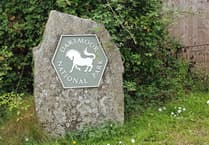An artist has lost his legal fight to keep the mural he painted on the side of his Bere Alston home which offended villagers.
Peter Churcher, of Fore Street, has been ordered by magistrates to cover up the colourful graffiti-style painting which includes a look-alike Duracell advert pink bunny.
Mr Churcher appealed against the order by West Devon Borough Council to 'obliterate' the painting in an alleyway, but magistrates turned down his appeal and presiding justice Christopher Hayball ordered that he cover up the mural in four weeks and to pay costs of £750.
Mr Hayball said the decision was not based on the artistic or other subjective merit of the mural, but that justices decided 'overall, the mural did not have a positive impact on the area (Bere Alston) and therefore, the appeal is dismissed'.
After the hearing at Plymouth Magistrates Court yesterday (Thursday) Mr Churcher vowed to redouble his efforts to be artistic. He said the planners had not used the right law.
Outside the court he said: 'It's a shame. I've put a lot of effort into fighting this, first the council and now in court to also persuade the magistrates. But I'm convinced the council used the wrong act to prosecute this and the magistrates were therefore, given the wrong advice. I did my best to show this in the court, but it was just me, the 'little man', against the power of the court and their experts and legal eagle.'
Judith Constable, for West Devon council, said Mr Churcher was served with an order to remove the mural under the 1990 Town and Country Planning Act section 2025 because it was 'detrimental to the amenity of the area' of Bere Alston.
But Mr Churcher had not complied. He had then appealed against the order which led to the hearing. Ms Constable told magistrates there was no strict legal definition of 'amenity' under the act, but that they should consider the meaning of the law with 'common sense'. She said the council considered the mural was 'out of place' in the 'context' of the village centre which was in a conservation area. She explained, for example, that murals at Marshmills in Plymouth or inner city London were more harmonious with their surroundings. A council official also said that public murals could also be more acceptable if they were carried out with the community involvement, such as an example in Okehampton.
Council officer Darren Jarvis told the court the mural was a 'poor reflection' on the appearance of the rest of Fore Street. Mr Churcher's house was in a 'poor state of repair' and the mural was 'out of keeping' and 'inappropriate' for the village. In January this year a 'defacement' order was served on Mr Churcher requiring him to paint over the mural. A council heritage officer said the mural did not preserve or enhance the conservation area.
Magistrates were shown photographs of the mural, which they were told some villagers had complained about and also said Mr Churcher's home, a former bookshop was untidy and an 'eyesore'. A complaint read out from Elizabeth McQueen, formerly involved in the village's Britain in Bloom entry, said the building let down the village in the competition when the surrounding houses were well presented. Magistrates were told Elizabeth McQueen complained to the council that Mr Churcher's house was dirty, with broken windows and that the mural was a 'monstrosity'. Any requests to clear up were faced with 'abuse' from Mr Churcher, she had said.
Dawn Rolls, who runs a hairdressers opposite Mr Churcher's house, said the mural was an 'eyesore' and it was not right that her customers had to look at it. She said it should be removed because it was out of keeping in a conservation area. She said the house was in 'general poor condition'. Ms Constable said Mr Churcher had previously filmed her and her young relative. She also said Mr Churcher had thrown water at someone outside his house.
Mr Churcher said he painted the mural in 2016 as part of his art. He ran an internet radio station, had 200,000 followers and promoted art online. He said the mural should stay because it was 'permitted development' under the 2015 Town and Country Planning Act and therefore, the council had no right to order its removal. The complainants mentioned in court were acting from personal dislike of him and his appearance, which was irrelevant under planning law, as was the appearance of his house. He denied pouring water on anyone and explained he filmed Dawn because she 'harassed' him, he alleged.
The mural had a lot of support, notably many positive comments from an online story from the Tavistock Times, he claimed.
Magistrates also considered letters from villagers supporting the right of Mr Churcher to paint his mural and to keep it because they enjoyed it.



